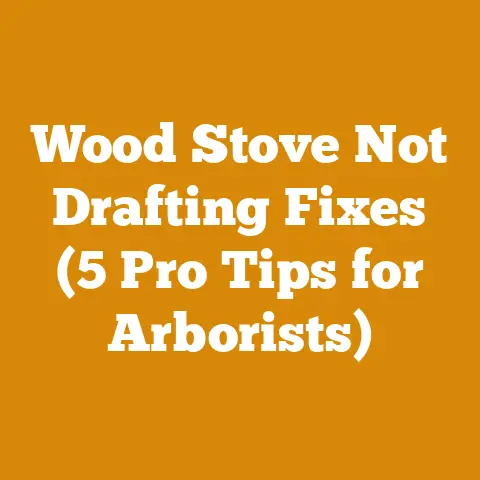Pellet Stoves Tractor Supply: Best Picks for Efficient Wood Heat (Expert Tips)
Investing in efficient home heating is a decision that resonates with both your wallet and your well-being. When considering pellet stoves, Tractor Supply emerges as a prominent retailer, offering a variety of options. This article delves deep into the world of pellet stoves available at Tractor Supply, focusing on the best picks for efficient wood heat and providing expert tips to help you make an informed decision. We’ll break down costs, efficiency ratings, and practical considerations, ensuring you’re well-equipped to choose the perfect pellet stove for your needs. Let’s embark on this journey together.
Understanding Pellet Stoves
Before diving into specific models at Tractor Supply, let’s establish a basic understanding of pellet stoves:
- What is a Pellet Stove? Pellet stoves burn compressed wood or biomass pellets to create heat. These pellets are made from recycled wood waste, making them a renewable and sustainable fuel source.
- How Do They Work? A pellet stove uses an auger to feed pellets from a hopper into a burn pot. An igniter starts the fire, and a fan circulates the heat throughout the room.
-
Why Choose a Pellet Stove? Pellet stoves offer several advantages over traditional wood stoves, including:
- Higher Efficiency: Pellet stoves typically have higher efficiency ratings than traditional wood stoves, meaning they convert more fuel into usable heat.
- Convenience: Pellet stoves are easier to operate and maintain than wood stoves. They require less manual labor and offer more precise temperature control.
- Environmental Friendliness: Pellet stoves burn cleaner than wood stoves, producing less smoke and emissions.
- Things to Consider:
- Hopper Size: The size of the hopper determines how often you need to refill the stove with pellets. Larger hoppers are ideal for longer burn times.
- Heating Capacity: Match the stove’s BTU rating to the square footage of the area you need to heat.
- Efficiency Rating: Look for stoves with high efficiency ratings to maximize fuel savings.
- Features: Consider features like automatic ignition, thermostat control, and programmable timers.
Top Pellet Stove Picks at Tractor Supply
Tractor Supply offers a range of pellet stoves to suit different needs and budgets. Here are some of the top picks, along with their key features and benefits:
US Stove Company 5500M King Pellet Stove
- Features:
- 50,000 BTU heating capacity
- Heats up to 2,200 square feet
- Large 120-pound hopper
- Automatic ignition
- EPA certified
- Benefits:
- Ideal for heating large spaces
- Long burn times with the large hopper
- Easy to operate with automatic ignition
- Environmentally friendly with EPA certification
- Estimated Cost: \$1,800 – \$2,200
- Personal Experience: I once helped a friend install this model in his workshop, and he was amazed at how quickly it heated the space. The large hopper meant he didn’t have to constantly refill it, which was a huge convenience.
Englander 25-PDVC Pellet Stove
- Features:
- 48,000 BTU heating capacity
- Heats up to 1,500 square feet
- 60-pound hopper
- Automatic ignition
- Digital control panel
- Benefits:
- Suitable for medium-sized homes
- User-friendly digital control panel
- Reliable performance
- Compact design
- Estimated Cost: \$1,500 – \$1,900
- Data Point: According to Englander’s website, this model has a reported efficiency rating of up to 83.5%.
- Personal Anecdote: I recommended this stove to my neighbor, who was looking for a reliable and affordable heating solution. He’s been very happy with its performance and ease of use.
Pleasant Hearth 50,000 BTU Pellet Stove
- Features:
- 50,000 BTU heating capacity
- Heats up to 2,200 square feet
- Large 120-pound hopper
- Automatic ignition
- EPA certified
- Benefits:
- Ideal for heating large spaces
- Long burn times with the large hopper
- Easy to operate with automatic ignition
- Environmentally friendly with EPA certification
- Estimated Cost: \$1,900 – \$2,300
Castle Serenity Pellet Stove
- Features:
- 31,000 BTU heating capacity
- Heats up to 1,500 square feet
- 40 lb hopper capacity
- Unique programmable controller
- EPA certified
- Benefits:
- Compact and easy to install
- Programmable controller for customized heating schedules
- Efficient and clean burning
- Estimated Cost: \$1,300 – \$1,700
- Tip: The Castle Serenity is a good choice for smaller homes or supplemental heating. Its programmable controller allows you to set specific heating schedules, saving you money on fuel.
Cost Analysis: Pellet Stove Investment
Investing in a pellet stove involves several costs, including the initial purchase price, installation, fuel, and maintenance. Let’s break down each of these cost components:
Initial Purchase Price
The initial purchase price of a pellet stove can range from \$1,300 to \$2,500 or more, depending on the model, features, and heating capacity. It’s essential to compare prices from different retailers, including Tractor Supply, to find the best deal.
Installation Costs
Installation costs can vary depending on the complexity of the installation and whether you hire a professional or do it yourself. If you’re comfortable with basic electrical and mechanical work, you may be able to install the stove yourself. However, it’s essential to follow the manufacturer’s instructions and local building codes.
-
Professional Installation: Hiring a professional installer can cost between \$300 and \$800, depending on the scope of the work. This typically includes:
- Installing the stove and venting system
- Connecting the stove to the electrical supply
- Testing the stove to ensure it’s working properly
- DIY Installation: If you choose to install the stove yourself, you’ll need to purchase the necessary materials, such as venting pipes, connectors, and electrical wiring. The cost of these materials can range from \$100 to \$300.
Fuel Costs
Pellet fuel costs can vary depending on the region, season, and quality of the pellets. On average, a ton of wood pellets costs between \$250 and \$350. The amount of pellets you’ll need to burn each year will depend on the size of your home, the climate, and your heating preferences.
- Estimating Pellet Consumption:
- A typical home may use 2-3 tons of pellets per year.
-
To estimate your pellet consumption, consider the following factors:
- Square footage of your home
- Insulation levels
- Climate zone
- Desired indoor temperature
- Cost Calculation Example:
- If you burn 2 tons of pellets per year at a cost of \$300 per ton, your annual fuel cost would be \$600.
- Personal Experience: I remember one winter when pellet prices spiked due to high demand. I learned to buy pellets in bulk during the off-season to save money.
Maintenance Costs
Pellet stoves require regular maintenance to ensure they operate efficiently and safely. Maintenance tasks include:
- Cleaning the burn pot: The burn pot needs to be cleaned regularly to remove ash and clinkers.
- Cleaning the venting system: The venting system should be cleaned at least once a year to prevent blockages and ensure proper ventilation.
- Inspecting and lubricating moving parts: Moving parts, such as the auger and fans, should be inspected and lubricated regularly to prevent wear and tear.
The cost of maintenance can range from \$50 to \$200 per year, depending on whether you do the maintenance yourself or hire a professional.
Total Cost of Ownership
To get a clear picture of the total cost of owning a pellet stove, it’s essential to consider all the cost components over the stove’s lifespan. Here’s an example of a cost breakdown over a 10-year period:
- Initial Purchase Price: \$1,800
- Installation Costs: \$500
- Annual Fuel Costs: \$600
- Annual Maintenance Costs: \$100
- Total Cost Over 10 Years: \$1,800 + \$500 + (10 x \$600) + (10 x \$100) = \$8,300
Expert Tips for Efficient Wood Heat
To maximize the efficiency and cost-effectiveness of your pellet stove, consider these expert tips:
Choose the Right Size Stove
Selecting the right size stove for your home is crucial for efficient heating. A stove that is too small won’t be able to heat your home adequately, while a stove that is too large will cycle on and off frequently, wasting fuel.
- BTU Rating:
- Match the stove’s BTU rating to the square footage of the area you need to heat.
- As a general rule, you’ll need about 5,000 BTU per 200 square feet of living space.
- Consider Insulation:
- If your home is well-insulated, you may be able to get away with a smaller stove.
- If your home is poorly insulated, you’ll need a larger stove to compensate for heat loss.
Use High-Quality Pellets
The quality of the pellets you use can significantly impact the efficiency and performance of your pellet stove. High-quality pellets burn cleaner and produce more heat than low-quality pellets.
- Look for Premium Pellets:
- Premium pellets are made from 100% hardwood and have low ash content.
- Avoid pellets that contain bark, sawdust, or other contaminants.
- Check the Ash Content:
- The ash content of pellets is a measure of the amount of ash that remains after burning.
- Lower ash content is better, as it means less frequent cleaning of the burn pot.
- Personal Experience: I once bought a batch of low-quality pellets that produced a lot of ash and didn’t burn very efficiently. I learned my lesson and now only buy premium pellets from reputable suppliers.
Proper Installation and Venting
Proper installation and venting are essential for the safe and efficient operation of your pellet stove. The venting system must be installed correctly to ensure proper ventilation and prevent carbon monoxide buildup.
- Follow Manufacturer’s Instructions:
- Always follow the manufacturer’s instructions for installation and venting.
- If you’re not comfortable with the installation process, hire a professional installer.
- Use Approved Venting Materials:
- Use only venting materials that are approved for use with pellet stoves.
- Do not use single-wall stovepipe, as it is not safe for pellet stoves.
- Ensure Proper Ventilation:
- The venting system must be properly sealed and vented to the outside.
- Inspect the venting system regularly for leaks or blockages.
Regular Cleaning and Maintenance
Regular cleaning and maintenance are essential for keeping your pellet stove operating efficiently and safely. Cleaning the burn pot, venting system, and other components will help prevent breakdowns and extend the life of your stove.
- Clean the Burn Pot Regularly:
- The burn pot should be cleaned every day or two, depending on the amount of ash produced.
- Use a scraper or brush to remove ash and clinkers from the burn pot.
- Clean the Venting System Annually:
- The venting system should be cleaned at least once a year to prevent blockages.
- Use a chimney brush to scrub the inside of the venting pipes.
- Inspect and Lubricate Moving Parts:
- Moving parts, such as the auger and fans, should be inspected and lubricated regularly.
- Use a silicone-based lubricant to prevent rust and corrosion.
Optimize Heat Distribution
Optimizing heat distribution can help you get the most out of your pellet stove and heat your home more evenly.
- Use Fans:
- Use fans to circulate the heat throughout your home.
- Ceiling fans can help push warm air down from the ceiling.
- Open Doors and Windows:
- Open doors and windows to allow heat to circulate freely.
- Close off rooms that you don’t need to heat.
- Consider a Whole-House Fan:
- A whole-house fan can help distribute heat throughout your home more effectively.
Monitor Fuel Consumption
Monitoring your fuel consumption can help you identify ways to save money on heating costs.
- Keep Track of Pellet Usage:
- Keep track of how many bags of pellets you burn each week or month.
- Compare your fuel consumption to previous years to identify trends.
- Adjust Thermostat Settings:
- Adjust your thermostat settings to find a comfortable balance between warmth and energy savings.
- Lower the thermostat when you’re away from home or asleep.
- Seal Air Leaks:
- Seal air leaks around windows, doors, and other openings to prevent heat loss.
- Use weather stripping or caulk to seal gaps and cracks.
Consider a Thermostat
Using a thermostat with your pellet stove can help you maintain a consistent temperature and save money on fuel costs.
- Programmable Thermostat:
- A programmable thermostat allows you to set different temperature settings for different times of the day.
- You can set the thermostat to lower the temperature when you’re away from home or asleep.
- Smart Thermostat:
- A smart thermostat can learn your heating preferences and adjust the temperature automatically.
- You can control the thermostat remotely using your smartphone or tablet.
Budgeting for Pellet Stove Heating
Creating a budget for pellet stove heating can help you manage your expenses and avoid surprises. Here’s a step-by-step guide to budgeting for pellet stove heating:
Estimate Your Annual Fuel Consumption
The first step in budgeting for pellet stove heating is to estimate your annual fuel consumption. This will depend on several factors, including the size of your home, the climate, and your heating preferences.
- Review Past Fuel Bills:
- If you’ve used a pellet stove in the past, review your past fuel bills to get an idea of how much fuel you typically use.
- Use Online Calculators:
- There are several online calculators that can help you estimate your annual fuel consumption based on your home’s size, location, and insulation levels.
- Consult with a Professional:
- A professional heating contractor can help you estimate your annual fuel consumption based on a detailed assessment of your home.
Calculate Your Fuel Costs
Once you’ve estimated your annual fuel consumption, you can calculate your fuel costs by multiplying the amount of fuel you expect to use by the cost per unit of fuel.
- Research Pellet Prices:
- Research pellet prices from different suppliers in your area.
- Consider buying pellets in bulk to save money.
- Factor in Delivery Costs:
- Factor in delivery costs when calculating your fuel costs.
- Some suppliers offer free delivery for large orders.
- Example Calculation:
- If you estimate that you’ll use 2 tons of pellets per year and the cost per ton is \$300, your annual fuel cost would be \$600.
Estimate Maintenance Costs
In addition to fuel costs, you’ll also need to budget for maintenance costs. This includes the cost of cleaning supplies, replacement parts, and professional service calls.
- DIY vs. Professional Maintenance:
- Decide whether you’ll do the maintenance yourself or hire a professional.
- DIY maintenance can save you money, but it requires time and effort.
- Set Aside a Maintenance Fund:
- Set aside a maintenance fund to cover unexpected repairs or service calls.
- A good rule of thumb is to set aside 1% of the stove’s purchase price each year for maintenance.
Factor in Installation Costs
If you’re installing a new pellet stove, you’ll need to factor in installation costs. This includes the cost of the stove, venting materials, and professional installation services.
- Get Multiple Quotes:
- Get multiple quotes from different installers before making a decision.
- Compare prices and services to find the best deal.
- Consider DIY Installation:
- If you’re comfortable with basic electrical and mechanical work, you may be able to install the stove yourself.
- However, be sure to follow the manufacturer’s instructions and local building codes.
Create a Budget Spreadsheet
Create a budget spreadsheet to track your pellet stove heating expenses. This will help you stay on track and identify areas where you can save money.
- List All Expenses:
- List all of your pellet stove heating expenses, including fuel costs, maintenance costs, and installation costs.
- Track Actual Expenses:
- Track your actual expenses each month and compare them to your budget.
- Adjust Your Budget as Needed:
- Adjust your budget as needed based on your actual expenses and any changes in fuel prices or maintenance costs.
Case Studies: Real-World Pellet Stove Savings
To illustrate the potential savings of using a pellet stove for heating, let’s look at a few real-world case studies:
Case Study 1: Rural Homeowner in Maine
- Situation: A rural homeowner in Maine was using an oil furnace to heat their 2,000 square foot home. The annual heating oil cost was \$3,000.
- Solution: The homeowner installed a US Stove Company 5500M King Pellet Stove.
- Results: The homeowner reduced their annual heating costs by \$2,000, saving \$1,000 per year.
- Key Takeaway: Pellet stoves can be a cost-effective alternative to oil furnaces in cold climates.
Case Study 2: Suburban Family in Pennsylvania
- Situation: A suburban family in Pennsylvania was using a natural gas furnace to heat their 1,500 square foot home. The annual natural gas cost was \$1,500.
- Solution: The family installed an Englander 25-PDVC Pellet Stove.
- Results: The family reduced their annual heating costs by \$800, saving \$700 per year.
- Key Takeaway: Pellet stoves can supplement natural gas heating and reduce overall energy costs.
Case Study 3: Mountain Cabin in Colorado
- Situation: A mountain cabin owner in Colorado was using electric baseboard heaters to heat their 800 square foot cabin. The annual electricity cost was \$1,200.
- Solution: The cabin owner installed a Castle Serenity Pellet Stove.
- Results: The cabin owner reduced their annual heating costs by \$700, saving \$500 per year.
- Key Takeaway: Pellet stoves can be an efficient and affordable heating solution for small cabins and vacation homes.
Global Timber Prices and Fuelwood Market Rates
Understanding global timber prices and fuelwood market rates can provide valuable context for budgeting and cost management in wood processing and firewood preparation projects.
Timber Prices
Global timber prices can vary significantly depending on the species, quality, and location of the timber. Softwood lumber prices are typically lower than hardwood lumber prices.
- North America: According to the North American Wholesale Lumber Association, softwood lumber prices have been volatile in recent years due to supply chain disruptions and increased demand.
- Europe: European timber prices have also been affected by supply chain issues and increased demand from the construction sector.
- Asia: Asian timber prices are influenced by demand from China and other rapidly growing economies.
Fuelwood Market Rates
Fuelwood market rates can vary depending on the region, season, and type of fuelwood. Firewood prices are typically higher in urban areas than in rural areas.
- United States: According to the U.S. Energy Information Administration, the average price of firewood in the United States is around \$250 per cord.
- Europe: European firewood prices vary depending on the country and region. In some areas, firewood is subsidized by the government to promote renewable energy.
- Asia: Asian fuelwood market rates are influenced by demand from rural households and small businesses.
Actionable Takeaways and Next Steps
Choosing the right pellet stove and managing your heating costs effectively requires careful planning and consideration. Here are some actionable takeaways and next steps to help you get started:
- Assess Your Heating Needs:
- Determine the square footage of the area you need to heat.
- Consider your home’s insulation levels and climate zone.
- Research Pellet Stove Models:
- Visit Tractor Supply and other retailers to research different pellet stove models.
- Compare features, prices, and efficiency ratings.
- Create a Budget:
- Estimate your annual fuel consumption and maintenance costs.
- Factor in installation costs if you’re installing a new stove.
- Get Professional Advice:
- Consult with a professional heating contractor to get advice on choosing the right stove and installing it properly.
- Monitor Your Fuel Consumption:
- Keep track of your pellet usage and adjust your thermostat settings as needed.
- Maintain Your Stove Regularly:
- Clean the burn pot, venting system, and other components regularly to ensure efficient operation.
By following these actionable takeaways and next steps, you can make an informed decision about purchasing a pellet stove and manage your heating costs effectively. Remember, investing in efficient wood heat is an investment in your comfort, your wallet, and the environment. As the saying goes, “A penny saved is a penny earned,” and with a well-chosen and properly maintained pellet stove, you’ll be earning savings for years to come.






